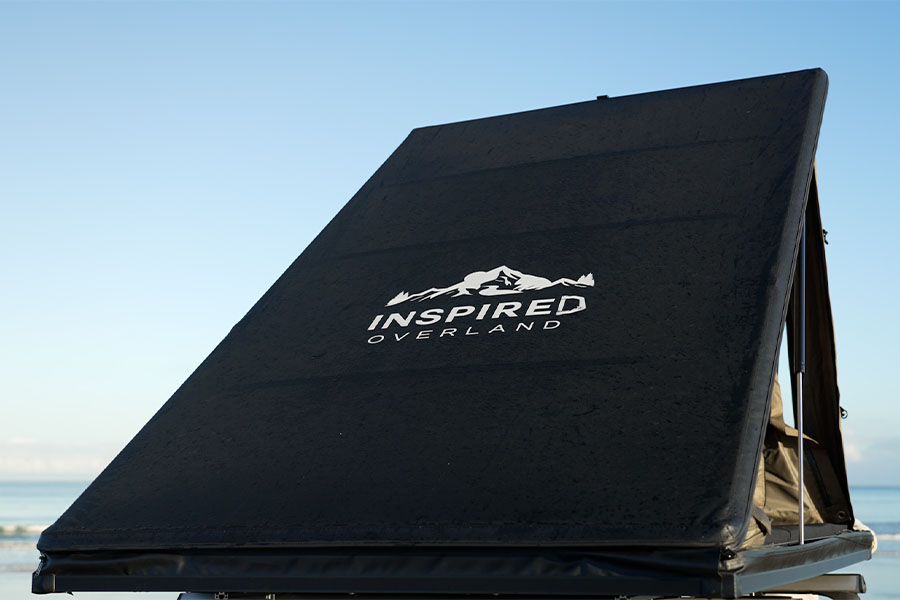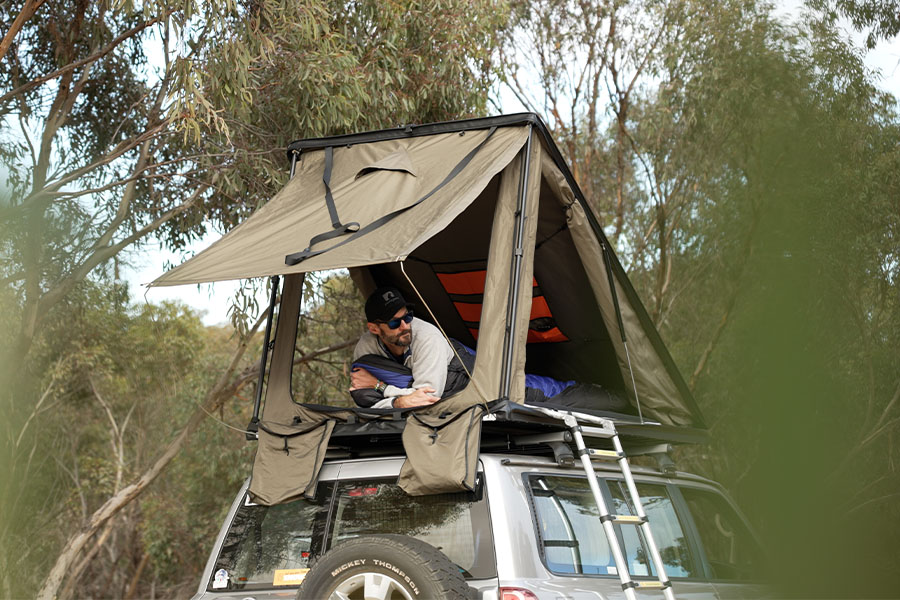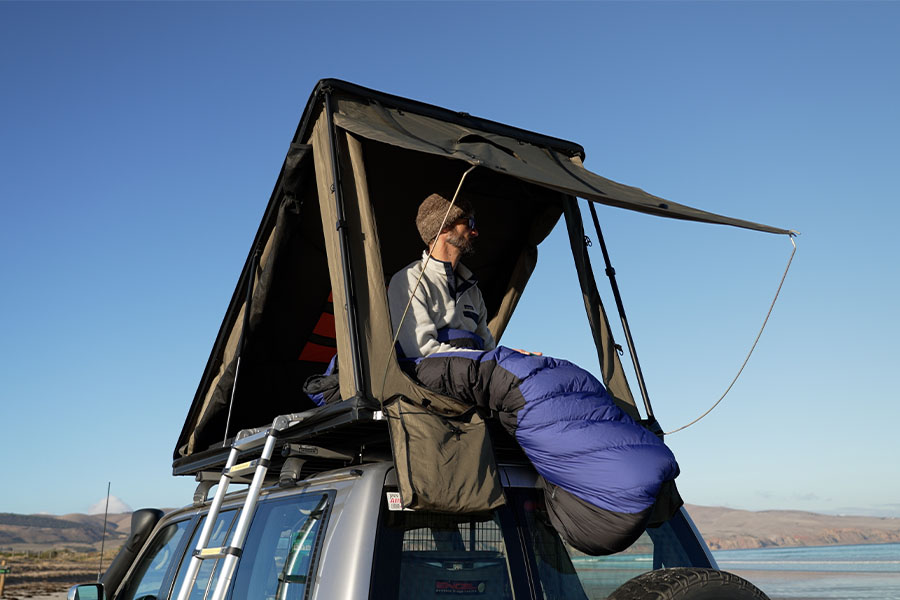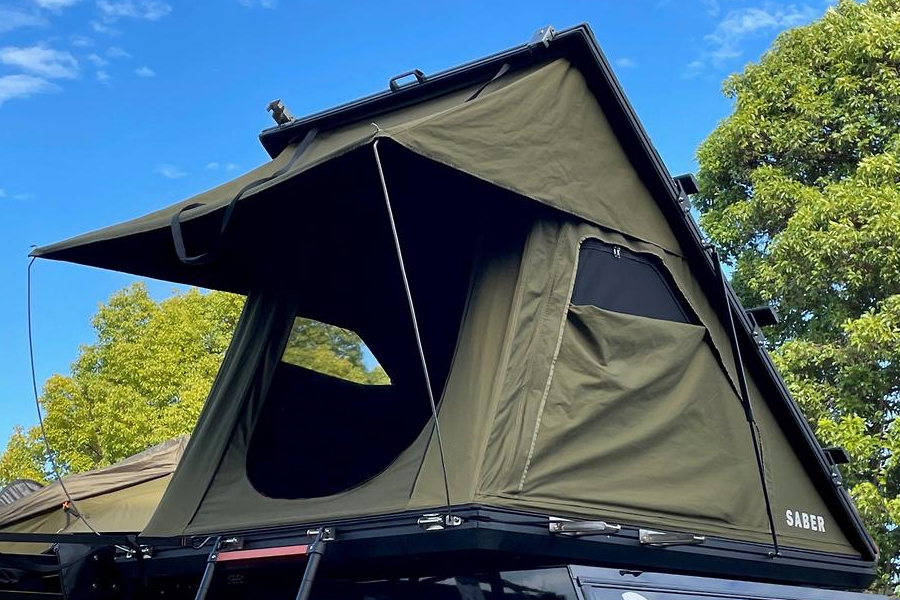Roof top tent, rooftop tent, or RTT… whichever way it’s written, this post is all about the camping accessory that allows you to safely and comfortably sleep on the roof of a vehicle!
Dating back as far as the 1930s, the basic concept of today’s roof top tents has, surprisingly, not changed a great deal. It’s a tent with a solid base that is mounted to the existing roof racks on your vehicle. Nowadays, there are both hard shell and soft shell variations. With the latter, a telescopic ladder doubles as a leverage point for opening up the tent – essentially creating an easy, pop-up solution!
There are many schools of thought around RTTs – some campers swear by them and others would rather spend their money on a different setup. Be you in favour or against, there are a bunch of questions worth asking before you make the decision:
- Is a roof top tent worth it?
- What are the pros and cons?
- Can my car support a roof top tent?
- What should I look for and consider when buying a roof top tent?
- What are the mounting options?
- Hard shell or soft shell?
- Which roof top tent is right for me?
So, we’ve done our best to answer some of these questions and help you choose the best roof top tent for you!

Darche roof top tents include the Hi-View range, the Panorama, the Intrepidor, and the Ridgeback Hard Shell in canvas and eco variations. Image: Darche
Is a Roof Top Tent Worth It?
There’s no point pretending otherwise, so we’re just going to tell it straight: yep, roof top tents are an investment, and the answer to whether or not they’re worth it is largely dependent on who you are, and what setup suits you and your adventure the most.
Depending on brand, size, features, quality, warranty, and more – roof top tents can range from $1000 to upward of $5,000. Then there are additional accessories such as annexes, racks, rails, anti-condensation mats, etc. It can all add up, and before you know it you’ve burned a serious hole in your wallet!
But – there are, arguably, more pros than cons to buying a roof top tent.

One of the great things about a roof top tent is they allow you to camp just about anywhere. Image: Darche
Pros and Cons
Pros:
- Super fast setup
- They allow a safe and comfortable sleep almost anywhere
- Off the ground – great when camping on tricky terrain, or to get away from creepy crawlies, snakes, and wild animals (including crocs, excluding drop bears!)
- More affordable than a camper trailer, camper, or off-road van
- The good ones can last up to 15 years!
- Bearing the load on top frees up space inside your vehicle
- A great alternative to towing
- They don’t affect your driving speed (*however, there’s a matching ‘con’)
- The mattress and bedding can be left inside when packed away
Cons:
- They’re heavy
- They cost more than a tent or swag
- Although driving speed is unaffected, RTTs increase drag and, therefore, fuel consumption (*this is the matching ‘con’ to the driving speed ‘pro’)
- If not mounted correctly, or if the weight exceeds your vehicle’s capacity, you risk damaging your vehicle (which can be costly and will void your insurance)
- You have to pack up to move your vehicle, whereas you can leave a tent at the campsite while exploring and day tripping
- They’re not necessarily suitable for family camping with young kids or those with limited mobility, since there is a lot of climbing involved
- They’re best removed from your vehicle between trips, so you need two people to lift the RTT on and off and somewhere to store it when not in use

Darche’s Intrepidor is the cheapest in their range and comes with a sky window for gazing at the stars. Image: Darche
Can My Car Support a Roof Top Tent?
The most important factor to consider before buying a roof top tent is your vehicle!
‘Will this roof top tent fit on my roof racks?’
This, or variations of it, is hands-down our most FAQ from customers. Nevertheless, despite a mountain of accumulated knowledge amongst the Snowys crew, we are not legally allowed to provide a definitive answer – nor can the brand of said roof top tent. However, the good news is that a roof rack specialist, like Rhino Rack, can!
You need to know the load rating of your roof racks AND your vehicle’s roof load capacity. The first, as already mentioned, can be answered by a roof rack specialist, or should be detailed in the paperwork you received when purchasing your racks. The second question regarding the roof load capacity of your vehicle should, again, be detailed in your vehicle’s manual – or, contact the manufacturer.

Roof top tents are heavy, so you need to make sure your vehicle and roof racks can take the weight. Image: Darche
The load capacity of your vehicle’s roof is the maximum weight that can physically be accommodated by the roof. It’s illegal to exceed this maximum weight capacity. To do so is not only dangerous but will also risk damage to your vehicle, and will void any insurance!
Just so we’re really clear, there are two weight capacities to be aware of. One is the maximum load your roof racks can carry, the other is the maximum load your vehicle’s roof can carry. Your roof racks will often accommodate a heavier load than your vehicle’s roof.
Be aware that the physical weight of your roof racks needs to be calculated in addition to the weight of the roof top tent, and the sum of those figures is the weight that must not exceed your vehicle’s roof load capacity.
Furthermore, if you plan to carry any additional gear on your roof – gas cylinder, jerry cans, swag, etc. – the weight of these items also needs to be factored in. Triple check your Gross Vehicle Mass (GVM) specifications – the GVM is the maximum allowed weight of the vehicle for driving on the road, and includes passengers, cargo, etc.

It’s important to factor in all your cargo when calculating the total weight. Image: Darche
Considerations When Buying a Roof Top Tent
- Your budget – balance how much you are willing to spend/invest with the frequency of use
- Sleeping capacity and how many people you need to cater for
- What setup and style of camping you prefer – remote, off-road/4WDing, beach, riverside, touring, family, solo, couple (this blog and this blog may help)
- Dimensions – in use and packed, including low-profile/aerodynamic options
- Weight – see the previous section, plus, ‘Hard Shell or Soft Shell’ section below
- Mounting – more on this below
- Features – skylights, seam sealing, mat thickness, ladder, Light Suppression Technology (LST), pre-fitted racks (for solar panels, SUPs, surfboards, recovery tracks, etc.)
- Build quality – materials, construction, components (brackets, etc.)
- Waterhead rating
- Ventilation/condensation – windows and built-in air vents
- Manufacturer’s warranty
- Do you want an annex? Not all RTTs are compatible with annexes

What features do you want in a roof top tent?
Mounting Options
Here’s something that is often overlooked – you don’t have to mount a roof top tent onto the roof of your vehicle!
There are other options worth considering, especially if you are on the fence and the only thing stopping you is the thought of the daily pack down so you can drive somewhere.
Most roof top tents can be mounted on two horizontal roof rack bars, and are then fixed at four points. Therefore, mounting can also be done to a freestanding frame, a trailer, or a boat trailer, where some people weld a frame over the top. Either setup allows you to unhitch and use your car for whatever you need.
They can also be mounted to Ute trays, whilst still leaving room for additional cargo in the tray itself. Just fix the roof rack bars to the tray walls across the width.
An additional point to note for those choosing to mount in the usual way – i.e. on the roof of your vehicle – is to ensure you have enough clearance for your antenna. Yep, you’d better believe it, it’s a mistake that’s been done many times before and many a curse word has ensued!
Roof top tents can be mounted on trailers. Image: Darche
Hard Shell or Soft Shell?
Is one better than the other? We could just about fill another pros and cons list here, but it boils down to three main considerations – cost, longevity, and weight.
Hard Shell
As their name suggests, hard shell roof top tents have a hard cover that is either constructed of fibreglass, plastic, or aluminium. They are hinged on one side and open up rather like a clamshell.
Hard shell RTTs tend to be on the heavier side which makes them more suitable for gutsier vehicles that allow for heavier loads, e.g. a dual-cab Ute with canopy. While they are more expensive, the additional weight and cost do come with perks…
They last longer, especially those with an aluminium cover and steel components! They also allow for additional roof rails where solar panels, recovery boards, SUPs, surfboards, etc., can be carried (so long as the weight of these is accounted for!). Generally, hard shells are faster to erect too, but not as flexible.
23Zero’s Saber Hard Shell uses gas struts to assist with opening and closing. Image: 23Zero
Soft Shell
Soft shell roof top tents are more in line with the original 1930s design and allow for a larger footprint. They are cheaper than hard shells but do not tend to have the same lifespan.
Most soft shell RTTs are of canvas construction – however, there are a few entry-level models using alternative materials.
Darche’s Hi-View 1400 is tough, durable, and compatible with the 1400 annex. Image: Darche
Which Roof Top Tent is Right For Me?
Roof top tents are one of the most convenient ways to camp and they are perfect for those who love to get away regularly, especially going off-road.
For Smaller Vehicles
Darche Intrepidor 3 1400 Roof Top Tent (Soft Shell)
When it comes to your comfort, this tent goes above (your vehicle) and beyond. With a lightweight structure, it can fit smaller SUVs and soft roaders, as well as most others. A softshell design enables a quick setup and pack-down, with a high-density mattress included for convenience and enough room for sleeping gear to remain stored when collapsed. Large, zippered windows and an adjustable fly provide maximum ventilation, prevent condensation, increase airflow, and protect from creepy crawlies. Admire the stars comfortably through the sky window, while a 1500mm water rating and seam sealing promises cosy, dry dreaming! Overall, this tent offers robust reliability and door-busting durability in the great outdoors.

When it comes to comfort, the Intrepidor goes above (your vehicle) and beyond! Image: Darche
Affordable All-Rounders
23Zero Dakota Roof Top Tents (Soft Shell)
The Dakota features 23ZERO’s Light Suppression Technology (LST), a dark coating on the inner walls that diffuses sunlight for darker mornings and cooler summers. Its durable 280 gsm polycotton tear-check canvas features a fine PVC coated insect mesh, an aluminium internal frame that pivots on a stainless-steel yoke, and an alloy telescopic ladder – so it’s built for the outback. A zip-down sky roof provides a stellar view of the night sky, full-width side windows and side vents provide plenty of airflow, and a poly ripstop fly prevents condensation. Compactly packed into a PVC transit cover with D ring compression strap – the Dakota offers a simple, comfortable, and light-diffused shelter.
Darche Hi-View Roof Top Tents (Soft Shell)
Suitable for a camper trailer or wagon, the Hi-Views from Darche are roomy enough for as few as two people in the 1400 and four in the 2200, reliable for touring. Extra wide, it’s constructed from fully seam-sealed polyester/cotton ripstop canvas for durability, a 1500mm waterhead rating, and an adjustable tropical fly to mediate condensation. See the stars through the zippered window, block insects from the full-width side windows, and enjoy airflow through built-in air vents. With internal storage pockets for stashing the essentials, and a telescopic ladder for easy access – the Hi-View from Darche is ideal for that trio of tourers looking to elevate their adventures.
Both tents are available in multiple sizes, and stand out on the market as affordable all-rounders.

A tent fit to withstand the uncompromising Aussie landscape. Image: Darche
Superior Soft Top
Darche Panorama 1400 Roof Top Tent (Soft Shell)
Often considered the Rolls Royce of rooftop tents, the Panorama offers premium dreaming! Boasting a low-profile design when collapsed, it features a PU waterproofed 320gsm ripstop canvas (heavier than that used for the Hi-View), HD compressed checker-plate base board, and a PVC tonneau cover for outdoor durability. The Panorama perches proud and sturdy owing to stainless steel hinges and an aluminium frame, climbing to new heights too with an alloy telescope ladder that extends to 2.3 metres. With its impressive 1500mm waterhead rating, the twin-needle, lock-stitched seams and reinforced bar tack stitching on stress points withstand wetter conditions, while a tropical fly mediates humidity and works hand in hand with the built-in air vents for airflow. Premium in both design and features, this tent is fit to withstand the uncompromising Aussie landscape.
For a Smaller Footprint: Tubs and Trailers
23Zero Panther Roof Top Tents (Hard Shell)
Representing true on-the-road royalty, the Panther (literally) raises expectations! A lift-and-fold design enables a quick set up by sundown and pack down by dawn. Strong enough to support the bigger dreamers, a two-piece aluminium baseboard boasts a lightweight honeycomb construction, topped with a memory foam mattress and polyester quilt for plush comfort out bush. Turn it on when off the grid with LED strip lighting and USB plugs, while T-slot racks enable solar panel mounting too. Arched windows on either side deliver good ventilation and a dry interior – and swap the city lights with the outback night, thanks to a removable flysheet and stargazing roof window. Internal storage pockets keep the tackle together, and shoe pockets keep your kicks from heading up sticks! Plus, built-in elastic shock bands allow for flat packing without the bulge.

From the dual cabs and canopies to the tub racks and trailers. Image: 23Zero
23Zero Yowie ABS Roof Top Tent (Hard Shell)
This one’s for the outback slumbers. From the dual cabs and canopies to the tub racks and trailers, the Yowie is an affordable option for the more modest of the nomads! Boasting an ABS shell, its raised X-frame design allows maximum interior headroom, while the zippered head vent controls air circulation. An aluminium baseboard is sturdy but lightweight, while the memory foam mattress provides luxurious comfort. Large side windows also maintain good ventilation, with full canopy covers for the wetter weather. From bright city lights to star-speckled nights, enjoy the stargazing roof window, telescope ladder, and a clear TPU window fixed to the flysheet. Keep your boots from scooting with external shoe pockets, and keep your sleep setup stowed on the open road thanks to bulk internal room. Plus, switch on with LED strip lighting and pack down flat without the excess flap thanks to the externally fitted bungee cord.
For the Bells, Whistles, and Bulk Space
Darche Ridgeback HighRize Roof Top Tents (Hard Shell)
Lift your tent game – literally, with the Ridgeback HighRize! Its twin-fold design allows a large internal space for two pillows and two sleeping bags, even when packed away. Enjoy a near-panoramic view of your surroundings through 6 windows that cover all sides of your tent, meanwhile providing exceptional ventilation enhanced by a breathable memory foam mattress. Both the canvas and fly boast a 3000mm waterhead rating, while the included mattress has a water-resistant base and anti-condensation mat for complete camp comfort. Like the original Ridgeback, German-engineered Stabilus struts make for effortless pack-up and pack-down, while a removable fly provides coverage through rain or shine. Light up date night with two integrated LED light strips – and good things come (and go) in threes, like the included ladder which can be mounted from any of the three entry points.

In the HighRize, enjoy a near-panoramic view of your surroundings through 6 windows that cover all sides of your tent. Image: Darche
For Adventurers Who Travel Light
Inspired Overland Lightweight Rooftop Tents | Standard, XL, and Carbon Fibre
From roadside retreats to off-track overnighters, the Lightweight Rooftop Tent range by Inspired Overland elevates every outdoor adventure!
The Standard Lightweight Rooftop Tent boasts a sleek yet rugged design with gas strut-assisted PVC softshell opening for swift setup and pack-down. Its tough 2000D waterproof Polyester Oxford fabric is UV-protected, heat-sealed, and double-stitched for ultimate strength in harsh Aussie conditions. Three exterior entry points and high-density tulle windows ensure easy access and superior ventilation, while the included 3.8cm foam mattress and anti-condensation pad deliver elevated comfort. Multiple storage pockets keep your gear organized, and the included telescopic ladder with an aluminium mounting base offers versatile roof rail compatibility.

The Lightweight Rooftop Tent range by Inspired Overland elevates every outdoor adventure!
For more spacious escapes, the XL Lightweight Rooftop Tent delivers all the Standard’s premium features with expanded dimensions for greater comfort. The same gas strut-assisted mechanism and robust 2000D Polyester Oxford fabric maintain quick setup and exceptional durability, while its 1.5-inch foam mattress offers plush support. Large built-in storage pockets and multiple entry points ensure both convenience and organization beyond the big smoke, making it perfect for longer outdoor adventures.

The roof top tent range from Inspired Overland combines slender builds with outdoor durability for truly elevated camping experiences!
For the ultimate lightweight luxury, the Carbon Fibre Lightweight Rooftop Tent blends innovation with exceptional strength. Its premium hardshell carbon fibre lid combined with a carbon fibre and aluminium frame delivers maximum durability at minimum weight. Unique heating and cooling ducts facilitate diesel heaters and air-conditioners for all-season comfort, while the included self-inflating air mattress takes sleep quality to new heights. Removable shoe bags in the large storage pockets and T-slot mounting base with exterior slots for accessories ensure this top-tier tent is as practical as it is impressive.
The Inspired Overland Lightweight Rooftop Tent range combines slender builds with outdoor durability for truly elevated camping experiences!

Boasting a sleek but rugged design.
For Easy Setups
23Zero Saber Hard Shell Roof Top Tent (Hard Shell)
The robust and reliable Saber Hard Shell from 23Zero meets the modern demands of lifestyle touring. Open the latch and the gas strut-assisted aluminium hull to reveal the outer tent, while the interior features a rebound foam mattress, padded anti-condensation mat, and space to leave your sleeping gear inside when collapsed. Keep the essentials close by in the two built-in storage pockets, or six removable pockets including a media device viewing sleeve and drink holders. Constructed from LST-coated canvas, this treatment diffuses sunlight and prevents invasive UV rays. Compatible with the separately available 270-degree or side awning too, create sufficient shade or shelter around your vehicle.
Darche Ridgeback Roof Top Tent (Hard Shell)
Boasting a leading-class interior, the Ridgeback is constructed from aluminium and premium quality polycotton canvas, while self-repairing coil zips and reinforced stitching has it as lightweight as it is heavy-duty. Sleek and unique, its profile turns heads while its compact design minimizes wind drag. Breathe easy with a zippered sky window, built-in air vents, and three full-width doors for ventilation, while a memory foam mattress, removable cover, water-resistant base, and anti-condensation mat have this a true rooftop hotel room. From downpour to drought, a 3000mm water rating, taped seams, and rubber weather seals reduce infiltration of heat, wind, and moisture. Shield from severe UV with UV50+ protection, and handle humidity with the removable fly. A simple flick of the latches guarantees an efficient one-person setup, while German-engineered gas struts allow effortless pack down.
Both tents can be enhanced with roof rails, where the Saber features three T-slotted roof bars to fix your paddleboard, bike, or recovery tracks, and the Ridgeback is compatible with separately available roof-rail accessory kits to elevate every road trip.

The Saber meets the modern demands of lifestyle touring. Image: 23Zero
Don’t sleep on these – sleep IN them! From a warranty perspective, we can only speak to the brands we are familiar with and our team report very few problems across our range. Some people do find installing roof top tents a little tricky, but it’s nothing that can’t be overcome and just part of the territory when mounting them. Once it’s on the car, you’re ready to roll – anywhere, anytime!
Which roof top tent is best for you? Get in touch if you need more help.
When it comes to camping, hiking, travel and adventure – the Snowys team have all the expert advice, guides, and tips on everything outdoors.


